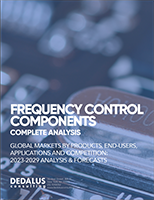The Impact of AI on Hardware and Frequency Control Markets: Networking Equipment
The market for components, equipment and devices needed for the integration and expansion of AI infrastructure and applications will see growth rates in the double digits – from 15-35% depending upon the equipment market – over the next several years.
As mentioned in our previous articles on the subject, in terms of frequency control and timing components, the growth of AI will have a direct impact on both the quartz-based and non-quartz-based markets. According to Dedalus Consulting, in their recently released report Frequency Control Components, the frequency control and timing components market will exceed $12.0 billion globally in 2024 across all markets. Each of these markets will continue to be integral in the implementation of AI.
AI's influence is profound in the frequency control and precision timing industry, reshaping hardware markets and driving impressive growth. As the demand for AI-driven solutions surges, so does the need for specialized hardware to support these innovations. In this series of articles, we have and will examine how AI is spurring growth in various hardware markets, and how this growth, in turn, fuels the expansion of frequency control components markets.
The Crucial Role of Hardware in AI
AI's rapid advancement is propelled by sophisticated hardware systems tailored to handle complex computational tasks efficiently. High-performance servers, storage solutions, networking equipment, telecom infrastructure, power supply, and management systems, as well as backup and redundancy systems form the backbone of AI infrastructure. Each of these hardware components plays a pivotal role in facilitating AI-driven applications and processes. In this article, we will look at networking equipment.
Integration of Frequency Control into Hardware Systems: Networking Equipment
Networking Equipment: Enabling Seamless Connectivity
AI is expected to optimize networking equipment design by simulating diverse network scenarios and identifying efficient configurations. This optimization process aims to enhance network traffic routing, bandwidth management, and security, leading to the development of more robust and reliable networking hardware. AI-driven networking equipment promises improved data throughput and reduced latency, vital for applications like 5G networks and IoT devices, which demand high-speed and dependable connectivity.
Produced by such industry leaders as Mellanox, Intel, and Cisco, some examples of networking equipment used for AI applications include:
• InfiniBand Switches: InfiniBand is a high-speed, low-latency interconnect technology widely used in AI clusters and supercomputers. These switches offer ultra-low latency and high bandwidth, making them well suited for AI workloads that require fast data transfer between nodes.
• Ethernet Switches are fundamental networking devices used in data centers and cloud environments to interconnect servers and storage systems. They provide connectivity for AI infrastructure components such as GPU servers, storage arrays, and compute clusters. While not as low-latency as InfiniBand, Ethernet switches offer scalability and compatibility with existing network infrastructure.
• GPUDirect RDMA (Remote Direct Memory Access)-enabled Switches allow GPUs in a cluster to directly access the memory of remote GPUs without CPU intervention, reducing latency and improving data transfer speeds. Switches with GPUDirect RDMA facilitate efficient communication between GPU nodes, enhancing the performance of AI applications such as deep learning training and inference.
Networking equipment, specifically routers, switches, and Network Interface Cards (NICs), relies on frequency control components to synchronize data transmission and reception. For example, phase-locked loop (PLL) circuits and voltage-controlled oscillators (VCOs) ensure precise clock signals, minimizing transmission errors and latency.
Frequency Control and Timing Components in Networking Equipment
Frequency control and precision timing components are crucial in networking equipment to ensure accurate data transmission, synchronization, and coordination among devices. These components help maintain stable frequencies for signals and ensure precise timing, which is vital for efficient communication and data processing.
One essential component used in networking equipment is the oscillator. Crystal oscillators, including temperature-compensated crystal oscillators (TCXOs) and voltage-controlled crystal oscillators (VCXOs), provide high-frequency stability and low phase noise, ensuring accurate data transmission and timing precision. MEMS oscillators offer advantages such as smaller size, lower power consumption, and higher shock resistance compared to traditional crystal oscillators, making them suitable for compact and rugged AI networking devices.
Another critical component is the phase-locked loop (PLL). PLLs are used to generate clock signals with precise frequencies and phase relationships, which are necessary for advanced modulation techniques and signal processing in networking equipment. They help maintain synchronization between different parts of the network, enabling smooth data transmission and reception. For example, in high-frequency trading (HFT) networks, where microseconds can make a significant difference, precise timing provided by these components is essential for executing trades with minimal latency. Digital phase-locked loops (PLL) offer advanced phase and frequency control capabilities in AI networking equipment, enabling precise synchronization with external timing references and adaptive frequency adjustments. These devices support fast-locking mechanisms and dynamic frequency tuning, optimizing signal stability and reducing synchronization latency in high-speed data networks.
Real-time clocks (RTCs) provide accurate timekeeping functions in AI networking equipment, maintaining the current date and time even during power-off periods. These devices are used for timestamping data packets, scheduling network operations, and synchronizing distributed systems in AI applications. RTCs ensure consistent timing across network nodes and support precise event logging and data synchronization, essential for efficient network management and operation.
As the demand for networking equipment continues to grow, driven by trends such as the proliferation of IoT devices, increasing data traffic, and the adoption of cloud computing and AI applications, the market for frequency control components also expands.
For example, consider the growth in demand for high-speed switches and routers to support the increasing data traffic in data centers. These devices require highly accurate oscillators and PLLs to maintain synchronization and minimize packet loss. Similarly, the deployment of 5G networks and edge computing infrastructure necessitates precise timing components to synchronize signals across distributed network nodes.
Networking equipment tailored for AI applications, such as InfiniBand switches and GPUDirect RDMA-enabled switches, offer low latency, high bandwidth, and efficient data transfer capabilities crucial for accelerating AI workloads. While they may come at a higher cost compared to traditional storage solutions, their performance benefits make them essential components in AI infrastructure deployments, particularly in high-performance computing environments and data centers.
Dedalus Consulting (www.dedalusconsulting.com) has recently updated Frequency Control & Timing Components - Global Markets, End-Users, Applications & Competitors, the completely updated 13th edition of Dedalus’ in-depth research on the global frequency control and timing industry.
|
|
|
About Dedalus Consulting
Dedalus Consulting is a privately owned and independently operated market research publisher and consultancy.
In 1996, Dedalus Consulting emerged as a pioneering technology-driven consultancy. Founded with a singular focus on delivering unparalleled market research and competitive intelligence, our mission has always been clear: to provide high-value insights that empower our clients to navigate the dynamic landscapes of emerging and mature technology sectors.
Our research focuses on both emerging and mature markets in high-technology sectors, including tooling and machining, advanced materials, frequency control and timing, surge and circuit protection, energy and renewables, life sciences, and next generation computing. Research is continually updated through a methodology that is based on primary interviews with market participants, including manufacturers, end-users, research institutions, distribution channel representatives and service providers.
Our clientele is as diverse as the industries we serve, ranging from Fortune 500 juggernauts to pioneering academic institutions. Whether you're shaping the future of technology or driving innovation, Dedalus Consulting is your indispensable partner in navigating the complexities of today's high-tech landscape.

